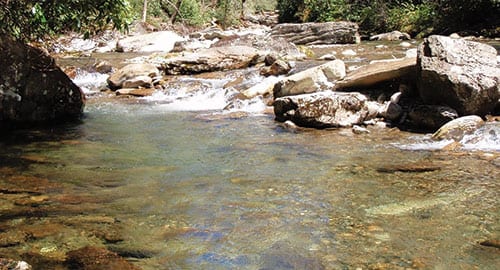The Raven Fork, inside the Great Smoky Mountains National Park, is an entirely different stream than the Raven Fork that flows through Cherokee, North Carolina. This stream is the most difficult stream to access in the park. Outside of the park, a road runs alongside the river, just about the entire length of the stream. Inside the park, the trout are all wild trout. Outside of the park, the stream is heavily stocked.
In order to fish the Raven Fork inside the park, you’re going to have to hike a good distance. The easiest way to get to the stream is a grueling hike over a steep mountain. It almost requires an overnight trip to fish there, otherwise, you will be hiking more than you will be fishing. The stream exits the park on private property and through a deep canyon that’s almost impossible to penetrate.
The Raven Fork is known for its large native Appalachian Brook Trout. The native Brookies average as large as they exist anywhere they’re found. The Appalachian Brook trout are a slightly different species from the Northern strain of brook trout.
Fly fishing the Raven Fork is as good as brook trout fishing gets.
Seasons:
The Great Smoky Mountains National Park is open for fly fishing year-round.
Spring:
Spring is the best time to fish the Raven Fork, provided there hasn’t been any recent heavy rain. Much of the river flows through canyon-like terrain and it’s not a good place to fish under high water conditions.
Summer:
The stream stays cool throughout the summer and fishing is normally excellent. Heavy tree cover shades the river its entire length.
Fall:
Fall may be considered the best season to fish the Raven Fork because the water level and weather are both normally stable.
Winter:
Wintertime is the least popular time to fish the river but not because the fish wouldn’t cooperate. Fishing is good unless the temperatures are below normal.
 Fly Fishing Guide to the Raven Fork:
Fly Fishing Guide to the Raven Fork:
Fly fishing the Raven Fork inside Great Smoky Mountains National Park is quite different from fishing most of the other trout or small, freestone streams of the park. It is very difficult to access and, in some areas, almost impossible to access. There are many sections of the stream where the only way to fish is to stay in the river and fish upstream. If you do the opposite, and fish downstream, you will spook most of the trout. Going upstream, even under normal water level conditions, can be very tough in many places due to the huge boulders you must get over or around.
You’re limited to the fly fishing gear you can pack in and out. The best way to get to the stream is via the Hyatt Ridge Trail. It’s almost a two mile, 2700 foot climb to the top of the steep incline. From there, you can coast downhill for almost another mile on the Enloe Creek Trail – that is if you don’t fall and break your neck on the loose rocks. The only place a trail crosses, or has direct access to the river, is where this trail crosses the creek at campsite #47. You must make reservations with the park officials to stay at this small campsite.
Even after you’re at the stream, fishing it isn’t easy. In fact, one needs to be in excellent physical shape to handle all the maneuvering and climbing. The stream is very steep with a lot of swift water and huge boulders the size of small cars. It’s difficult to navigate up the stream. There are few riffles. Most everything plunges from one deep pool to another in the area above the campsite. Everything may not sound so bad until you realize the only way back to the camp is downstream the same way you climbed up.
James Marsh is the Owner of The Perfect Fly online and catalog mail-order store. www.perfectflystore.com

